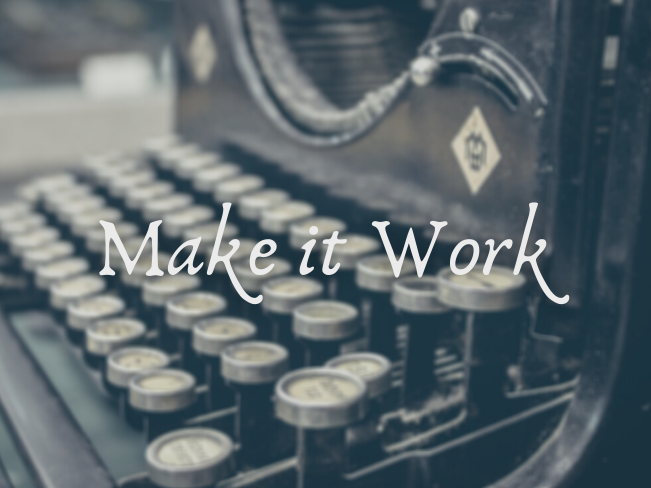
The new year is coming — and you know what that means.
Time to pick up a habit for about four days before getting frustrated, letting it slide, and falling far enough to bury our sorrows in chocolate by mid-February.
…anyone? No? Just me?
I find it incredibly hard to stick to my resolutions. In late December and early January I’ll come up with reams of ideas and get fired up by all of them. Though I’m unstoppable on January 2nd, by January 22nd… well, you get the picture.
Why is it so hard to stick to new year’s resolutions?
Because I dream too big when I make them.
I don’t mean to be a cynic — that’s not my style. There are plenty of times when I need a push to dream bigger and to take risks. Resolutions are different. Resolutions are about building better habits and making steady progress towards a goal. But if you’re anything like me, you come to this time of year primed with Big Ideas…
…too many Big Ideas.
Goal or Habit?
When I’m writing my resolutions, I tend to focus on goals, ie: where I want to be in a year’s time if everything goes according to plan. Though I’ll think about the path I need to take to get there in broad, sweeping strokes, I rarely consider the nitty-gritty details: the building blocks of daily habits.
I’m great at dreaming up lofty goals: writing two books in 2021, query agents, enter a novella-writing contest…
I’m not as good at laying the groundwork for the habits I need to develop in order to get me to those goals.
Where do you fall on that spectrum? If you’re goal-oriented like me, you’ve got your eyes on the distant prize and not on the day-to-day. (If you’re a details thinker, all of this is old hat for you — and I envy your mindset!) Big-picture folks like me will struggle to reach the prize because we have trouble structuring the day-to-day. Our journey needs a roadmap. The bigger the goal, the longer and more complicated the roadmap becomes. Without one, we end up lost and sidetracked early on.
Those detours are discouraging. We put in effort and see no progress. Over the course of weeks, our enthusiasm for reaching our goal erodes, leaving us frustrated with ourselves and disappointed with the outcome.
This year, I’m combatting bad habits by trying something new.
Set Fewer, Smaller Goals
Here’s my theory: Momentum is King.
I want do do everything in my power to avoid losing momentum. I know from years past that when the momentum is gone, fighting inertia to jumpstart my resolution engine is almost impossible. For me, that means setting aside the big goals for smaller, more manageable ones. If I have a big project on my mind, I’ll break it down into smaller chunks, and only invest energy into tackling that very first block. Depending on my level of momentum throughout the year, I might even shift projects around, foregoing an epic-scale project for something on the backburner that’s easier to push through.
Point is: getting started is the hardest part. I want to set myself up for early wins, build momentum, and tackle more difficult projects once I’m ready.
I’m so, so tempted to plan my entire year — to have a list of projects I’ll work on month-by-month between now and December. But if this past year taught me anything, it’s that life throws a mean curveball. I don’t want to pack out my writing schedule a year in advance, because when those best-laid plans inevitably go awry, I’m going to feel like I’ve dropped the ball — and there goes my momentum.
I do have some year-long goals for larger projects with fixed deadlines. There’s no helping that. But I’m resisting the temptation to add more and overload myself. Fewer goals, smaller goals.
By smaller goals, I also mean shorter-term goals. Right now, I’m trying to plan only a month or so in advance unless I have a compelling reason to do otherwise.
For example:
My one big (fixed) goal: finish books two and three of the Oceana Series by the end of 2021.
If that’s the big bad, then everything else has to work around it. Looking at my calendar, I’ve blocked off my busiest months (June, July, August), knowing that I won’t have time or energy to work on anything else. Now I’ll let myself look at the rest of the year…
…and force myself to plan my goals as if I’ll operate at 50% of my estimated productivity.
Why? Because I feel absolutely awesome when I nail goals early and add more to my plate, but feel terrible when I’m overdue. Even when due dates are artificial, even if the goal only exists in our head, I know I failed to meet it.
I’m not putting myself in that position this year. As a result, I’ve only planned for one additional project in February — completely ignoring the rest of spring and fall. I’m not trying to ‘reach the sky and land among the stars‘. I’m trying to reach for what’s right next to me, extending myself further only if it looks like I have a reasonable shot at grabbing it without making a mess of things.
I can always add more to my plate when February is through and the contest is finished.
It’s a lot harder for me to take things away.
Small, Recurring Goals Help Build Habits
The hardest part about bringing goals from resolution to reality is drafting (and executing) a functional roadmap. I often bite off more than I can chew and grow frustrated when results fail to materialize. This year, I’m dreaming big but thinking small.
Instead of asking myself how much I can write in a day, I’m working out my comfortable wordcount based on averages drawn from productivity stats in my writing software. NaNoWriMo’s website is also a fantastic tool for this — it helps you set goals and log wordcount if that’s a metric you like to use.
For those of you who prefer to use time-based metrics, I also have a tool for that. I use a time cube (mine is by Datexx). Over the past months, I’ve fiddled with periods of work and rest to figure out what’s most efficient for me. Do I get more done in fifteen-minute sprints, or thirty-minute sprints? What’s the optimal break length between sprints? How many can I do in a row before I need to get up and move around?
By working with my natural tendencies instead of pushing myself to meet an outside ideal (like that good old 1,667 words a day for NaNo), I’ve discovered my current average pace and have an idea of how long it will take me to reach my goals — and how much harder I’ll have to push myself if I want to get there in time.
This is where the real work of goal-setting lies. When it comes to resolutions, there’s often a gap between our current behavior and our ideal behavior. Looking at our writing habits can help us figure out how big that gap is and how we want to address it. Is it possible to go from writing 0 words a day to writing 1,667 every day for the rest of the year? Sure. But is it probable? Well — that’s another matter entirely, isn’t it?
If I want to build productive habits, I need to pick goals suitable for marathons, not for sprints. This year, I’m only considering resolutions that lend themselves to goals I can achieve with small, simple habits I can execute on a daily basis. Whether it’s writing for an extra fifteen minutes in the morning or eeking out 200 more words by the end of the night, the change must be executable and indefinitely sustainable.
But Cee, you might say, that won’t get me where I need to be by the end of 2021!
Maybe not. Maybe you’re ready to push yourself a little harder than I am right now. But I’ll say this much: a slow on-ramp to a lifestyle change is far more effective than a giant, vertical leap. Perhaps it’ll take me longer to get to where I’m going, but incremental, habit-based steps towards smaller goals will help me make sustainable lifestyle changes. These changes in lifestyle lay the groundwork for bigger, more pronounced movements towards my goals in the future. They provide a shot at early success without completely overwhelming me.
Underpromise, Overdeliver
When I get started this January, I won’t leap back into writing 1,667 words a day — even if that’s the ultimate dream by the end of the year. I need to start slower and work my way up to it. I need to build a minimum habit I can fall back upon when times get tough and work gets busy.
When 2021 gets rolling, I’m aiming for 1k a day. I know I can meet that goal. I know I can turn that into a habit by the end of the month. I’ll likely exceed that daily goal most days of the week. Then, when February comes around, I can ask myself again: how much can I do this month? What’s my average? What would that average look like if life took a swing at me? Maybe I’ll stick with 1k a day — or maybe I’ll adjust the goal. Either way, I’ll have a month of success under my belt and a ream of data about how I did to pull from as I make my decisions for February.
Most importantly, though, I’ll have momentum. I’ll feel good about my progress and excited to continue working on my resolution.
And that’s the hardest battle won, isn’t it?
What Are Your Resolutions?
Join me in the comments and tell me about your writing resolutions.
What are your goals?
How are you going to break them down into manageable pieces?
What habits do you need to build to achieve them?
How do you plan to scale those habits in a sustainable way?
I hope that, this year, we can all support one another through our 2021 writing resolutions.
…
Looking for ways to jump-start those daily word-counts? Join me on Tuesday, Thursday, Saturday, and Sunday for Morning Pages: writing prompts meant to spark your creativity and get words flowing onto the page. Answer discussion questions, chat with others in the comments, and share the snippets you wrote in response to the prompt!
Find Morning Pages here.
 Make it Work
Make it Work Are You Telling a Story or Writing Alt Text?
Are You Telling a Story or Writing Alt Text? Why Your Opener Isn’t Working
Why Your Opener Isn’t Working
Leave a Reply